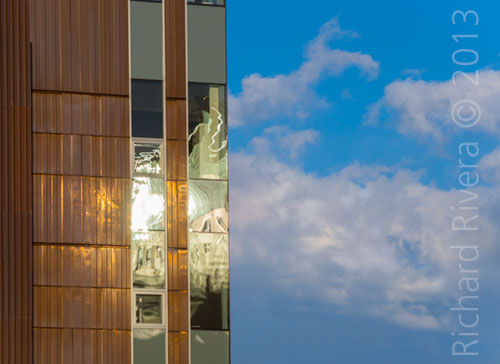
Your feedback and comments are appreciated. See Contact page for e-mails.
Camera Sense Archives
APRIL 2015
Book review
iPad software
Movie review
Underwater dual-use camera review
Photo commentary
Book review
PhotoTech commentary
The Interview, movie review
Photo enhancement or management
MAY 2015
Photo Tech commentary
Photo/Art commentary
Camera review
TV series review
JUNE 2015
JULY 2015
AUGUST 2015
SEPTEMBER 2015
OCTOBER 2015
Review by Richard Rivera
The Olympus E-M10 is a very compact Micro-Four-Thirds mirrorless camera with
3-axis in-body stabilization. It has excellent image quality due to the fact that it shares the same sensor and processor with Olympus’ flagship model, the E-M1. The build quality is very good, the body is small, light weight, and offers a wealth of features such as 3-axis in-body stabilization, two-wheel control similar to the E-M1,
a high resolution LCD, touchscreen, touch AF shutter/exposure via its touchscreen, the ability to be highly customized through its user preference choices, and re-assignable function (Fn) buttons and PASM dial.
Since the Micro-Four-Thirds sensor is smaller than full-frame and APS-C, shorter
focal length lenses will render the field-of-view equivalent to longer focal lengths,
i.e., a 12mm will show approximately the same f-o-v as a 24mm in full-frame (35mm). Therefore a Panasonic 45-150mm lens in Micro-Four-Thirds that is as compact as 50mm full-frame lens, but has the effective focal length of a 90-300mm. This allows Micro-Four-Thirds cameras (Panasonic and Olympus) to create smaller, lighter, and less costly lenses that are equally sharp as their larger counterparts.
One of the benefits of mirrorless cameras is that since the mirror box assembly and pentaprism is no longer required the camera bodies can be quieter, thinner, and much lighter in weight. Thinner bodies also means that “full-frame” (35mm), or other format lenses, can usually be used via adapters, that in effect are spacers, allowing the lenses to retain manual focus to their normal distances.
Such was the case with the photo pictured above. Sky and Metal Reflections was taken with a AF-S Nikkor 55-200mm G DX VR zoom lens on the E-M10 via a Nikon G to Micro-Four-Thirds adapter. I should note that in using most lenses via adapters they lose the ability to autofocus and automatic aperture control.
The image pictured below, Twisting Sprout with Fly, was shot with an old enlarging lens, which I happen to have, using extension tubes on the E-M10. And since the E-M10 features in-body stabilization, it greatly enhances handheld macro shooting.
The 3-axis in-body stabilization of the E-M10 works well although not as efficiently as the more advanced 5-axis system in the E-M1. It works automatically with either Panasonic or Olympus lenses. It also works with manual lenses of different brands via adapters, but requires the user to manually set the focal length for each lens that is being used in order to ensure proper stabilization. Zoom lenses are also usable but require the user to enter a different focal length each time the zoom setting is changed.
The high degree of customization allows the user to replace or reprogram any of the PASM (Program/Aperture Priority/Shutter Priority/Manual) dial modes with a MySet that is enabled by user set preferences. While this feature does enhance the camera to an amazing degree it may require a call to Olympus Customer Service to walk you through the steps.
In my shooting experience here is what I found as both positives and negatives that most impacted my handling and results:
The Minuses
• Handling is poor. Unlike the E-M1, the built-in grip of the E-M10 is negligible.
Useless for long lenses, but very useful for small or wide-angle lenses
• cramped layout, too many buttons surrounding shutter release
• Not enough Function (Fn) buttons (only 2 if you want to retain Video Record)
• Adequate electronic viewfinder image (EVF) of 1.4mil dots. Okay for AF but
a bit rough for detailed manual focus
• Peaking colors are only White or Black, no Red or Yellow
• Peaking works very well on highlights or contrast areas, not as well in
shadow areas
The Positives
• Excellent image quality
• Very compact and light body
• Efficient two main-dial(s) design
• Fast AF
• bright and sharp LCD
• Responsive touchscreen (allows magnified manual focus, shutter release,
and magnified review of images)
• Great bokeh with f/1.8 lenses (including the 45mm f/1.8, 17mm f/1.8, 75mm f/1.8)
• Efficient in-body 3-axis image-stabilization (with 3rd party manual focus
zoom lenses you must enter the focal length to be stabilized EACH TIME YOU
CHANGE ZOOM length because info is NOT being transmitted automatically)
• Very useful Magnified View options
• Continuous shooting in Magnified Mode
• High degree of customization
• Small AF lenses
• MySet can reprogram any of the PASM modes to your pre-configured settings
April 19, 2015

Sky and Metal Reflections, 2014
(at left)
shot with the Olympus E-M10
and the AF-S Nikon 55-200 f/4-5.6 G DX VR.
I should note that
used of the Nikkor zoom was possible with a Nikon G
to Micro-Four-Thirds adapter.


Twisting Sprout
with Fly, 2014
(at left)
shot with the Olympus E-M10
and Rodenstock Omegar 75mm @f/5.6
Detail at 50%
actual size
(below)

Copyright © 2015 Richard Rivera & Rivera Arts Enterprises All rights reserved. No copying or reproduction of any kind without express written permission from Richard Rivera
Legal Disclosure Camera Sense and Eagles of New York are trademarks of Elk Partners LLC